Beginners in search engine optimization (SEO) must understand that there is no magic way to get a site to the top of search engine results. This is done by complex algorithms and it takes a lot of effort to 'convince' them that your site or page deserves one of the top positions.
However, there are some rules that you can follow in order to improve the results of your site. I will present to you the steps of SEO for beginners and I will explain on a theoretical level.
What are the steps of SEO for beginners?
I tested this strategy over the past years on some of the sites I work on, with noticeable results. Of course, there are many other factors that can be done to help improve the site’s ranking, but the tips that I will tell you are 100% safe, and above all, they achieve results for you.
In addition to the tips, I will add real examples to my site, to help you understand how to apply these tips on your site or blog.
1. Title and description of the article
Article title
The title of the article is a very important factor in SEO, and the reason is that it is the first text that appears to the user in the search results. You must be careful in choosing the keywords to add to the article title. Choosing a keyword carefully makes it easy to compete for it in the search results.
The most important thing to focus on when writing the title of the article:
- Write an attractive and exclusive title that describes the content of the article page.
- As much as possible, try to add the keyword at the beginning of the title.
- Help the visitor understand what you are talking about inside the article through the title.
- The article title must not exceed 70 characters.
Site name : After adding the article title, insert the site name.
For example:

Another example of an article title:

Description of the article
Also, the description of the article is very important. It gives users and Google a brief synopsis of the content of the article. Google may show what you added in the article's Meta Description, or it may excerpt part of the page's content.
Important tips for writing a good description:
- Add a unique description to all pages, whether a product or an article.
- The description must not exceed 170 characters.
- Avoid repeating the title content in the description.
- Add the keyword in the description a maximum of two times.
- Try using the article description as a way to advertise your article to the reader.
2. Structure the page link
Page link structure is a term used to describe URL page links. The page link appears in the browser and in search results (under the page title).

How to choose a site link structure
- Make article links simple and easy to understand for search engines and users.
- Use the dash sign (-) to separate each word.
- Avoid long links with unnecessary information.
- Add the target keyword in the page link.
Examples of bad link structure
- https://www.example.com/EG/123213/5005.html
- https://www.example.com/socialmedianews
- https://www.example.com/id=5&sort=A&action=50
Good examples of link structure
- https://www.example.com/social-media-news
- https://www.example.com/2019/12/social-media-news
3. Breadcrumb
You must add this feature to your site. Breadcrumbs are a group of links at the top of the page that help search engines and the user know which section the article belongs to. If you use WordPress, there are many free breadcrumb plugins out there.
Browse the article on the best free WordPress plugins
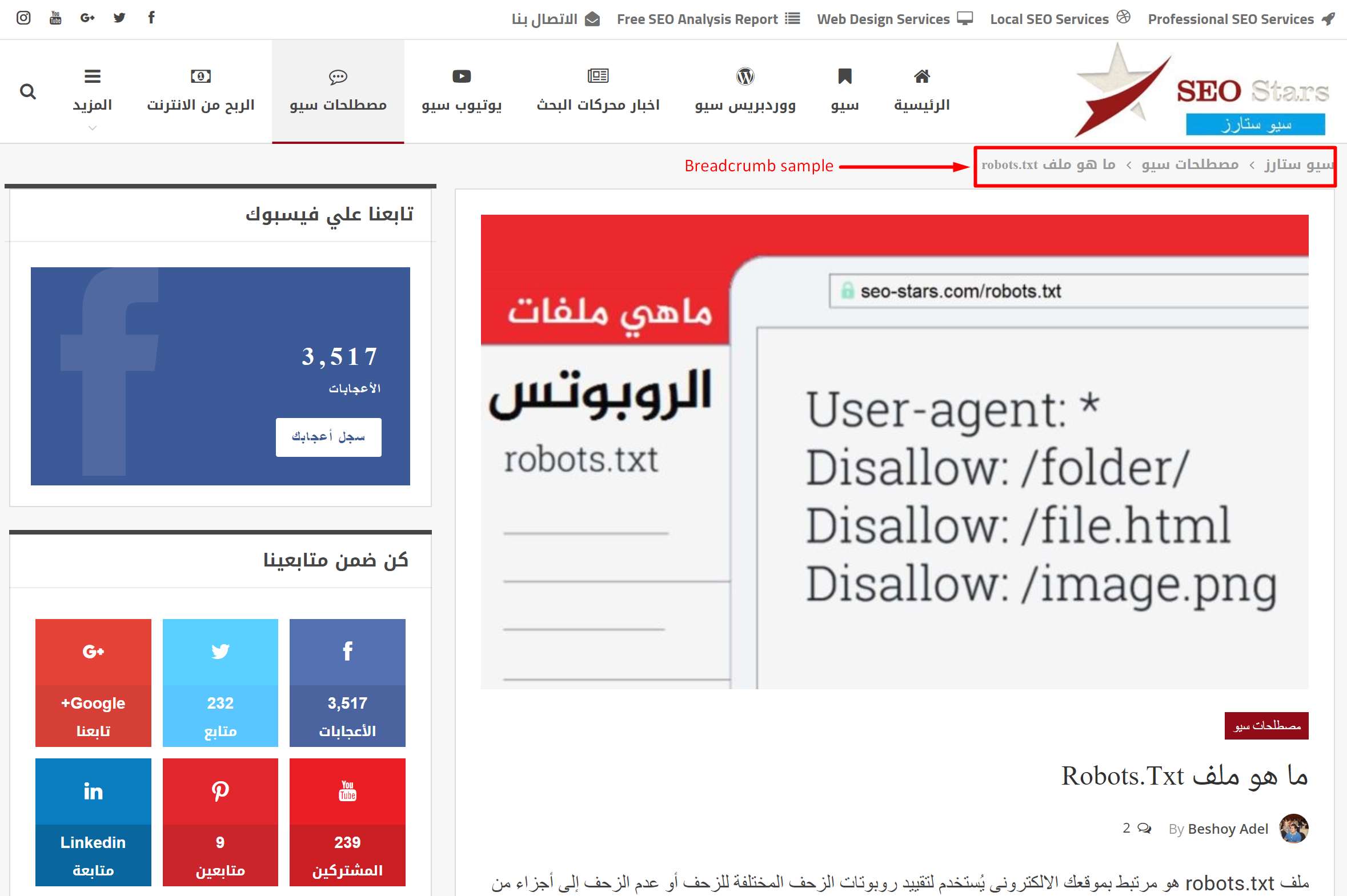
4. Internal links
When we talk about internal links, we mean links that exist on a page within the site and point to other pages within the same site. In the following example, when you click on “build a backlink,” you will be redirected to another page within the site to learn more information about how to build a backlink .
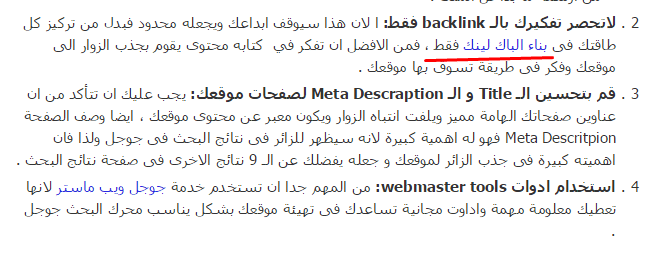
Internal links are a very important factor in improving SEO, but many website owners still do not use them correctly. These are the most important internal linking rules that must be followed:
- Exchange links to related articles either using the text of the target word or using the article link.
- Make sure that internal links will benefit the visitor and improve search engine indexing of the site.
- Don't post internal links just for search engines. An internal link should help the visitor navigate your site better. This will improve the length of time the visitor stays on the site and thus reduce the bounce rate .
- Do not use phrases like “click here” or “[..] in the internal link with the word. This will harm your site and will make the visitor not understand what this link is about, so he will not click on it, and will even harm the article referred to.
- Do not exhaust yourself, 4-5 internal links on each page are sufficient (create more if necessary), but do not exaggerate so as not to negatively affect the site’s ranking.
- Do not just create links from new articles to old articles, but every few days, add internal links between new topics and old topics. It's not an easy task to do, especially if you have a lot of articles, but it's a valuable way to do on-site SEO.
5. Format content and use H1 and H2 tags
New articles should not be published without reviewing them and carrying out the internal SEO process. This is not good for a site ranking improvement strategy. The rules to follow to format an article or page on your site are:
- Use H1 tag as article title.
- Use H2 for subtitle within the article.
- Use bold or italic font to attract visitors' attention to a specific sentence or word.
- Don't use H2 with all subheadings.
- Write small lines as advice or clarification of something.
- Use small font because it is easy to read. I don't mean to use a font that is too small to be seen, but it's good.
When formatting your posts, always keep in mind that they appeal to the user.
Ask yourself
Can the visitor get to know the details of the sub-sections in the article (H2 headings) only through an overview?
Is the text easy to read even on mobile devices (Apple iPads, Android tablets, etc.)?
6. Page 404
SEO is to improve the user experience, and the 404 page contributes to achieving this goal. Page 404 is the page that appears when a visitor clicks on a link that is not on the site or a misspelling error in writing the article URL. If there is no 404 page on the site, it will receive this error:
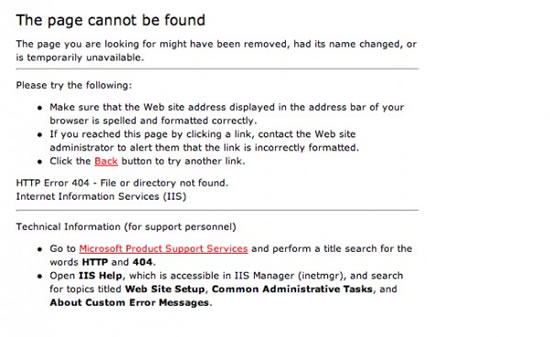
Factors for creating a good 404 page :
- Give the visitor some information about what happened instead of displaying “ Not found .”
- Make the 404 page design consistent with the website pages.
- Give the visitor options to move to other pages within the site .
This is a 404 page model on the SEO Stars website. I help him return to the home page or search the site for what he wants.
7. Optimize and prepare images
Inserting some images into articles is necessary to enhance the user experience and diversity of content, but care must be taken to avoid side problems such as problems with page loading speed or site responsiveness. Especially after the success of Pinterest, many sites began uploading images to their account and then inserting a link to the image within the article. If you decide to use photos, avoid making these mistakes:
- Describe the image using Alt text . You can add keywords in the description of images, but do not exaggerate.
- Use keywords to name pictures . Avoid using names such as image1.jpg or person1.jpg. Instead use meaningful nouns with dashes as a separator between each word. For example best-wordpress-theme.jpg.
- Collect image files into one folder within the site. Select one folder within the site to upload images to, such as www.mydomain.com/images.
- Improve image size . Click on the image size (make its size in KB). This will make the site faster.
Browse the best WordPress plugins section , you will find many image size compression plugins.
8. Site speed
Certainly, site speed is a very important factor in the success of the site, in addition to that Google mentioned several times that site speed is an SEO factor and therefore important in order to improve search results.
Websites with good loading speed are preferred by visitors because it is a factor that encourages the visitor to return to the site again. In addition, if your site load time is less than 8 seconds, you are likely to get:
- Better ranking in search engine results
- The visitor browses more than one page
- More visits
Site speed improvement factors
- Remove any unnecessary plugins (if you are using WordPress) or JavaScript codes.
- Reduce the size of images.
- Using caching plugins (we use the WP Fastest Cache plugin)
- Use Google's website speed measurement tools for free, which is a service to analyze your site and get tips for improving site performance. Website speed testing tool
Addressing technical problems It is not easy for the average person to identify and solve problems. But it is one of the very important factors in the SEO strategy. You can agree with a programmer to improve the site’s performance through odesk.com, for example, or the Khamsat website .
9. Authored by Google
What is Google authorship status?
It's a way to link your content with your Google+ profile. When you do this successfully, your image appears in Google search results next to your content.
How do you best relate to the author's search engine status ?
- It helps improve your site's credibility in the minds of users and search engines.
- Studies have shown that people are more likely to click on a link from search results if the author is verified.
- You can increase your chances of getting a natural backlink (people are the best way to reach your site if the author's status is verified).
Update: (Google Authorization Agent has expired and is no longer useful)
10. Your site is compatible with phones
A large number of searches done every day are through mobile devices. Numerous studies over the past 6 months have determined that the number of searches using smartphones is continuing to increase, especially when it comes to online purchases.
I'm confident that if you take a look at your data analytics you will see a good percentage of daily visits coming from smartphones. In the example below, approximately 30% of traffic is from mobile with Apple products (iPhone, iPod and iPad).  It's not within the scope of this article but there are some simple steps you can follow to ensure your site is mobile responsive.
It's not within the scope of this article but there are some simple steps you can follow to ensure your site is mobile responsive.
- The first thing I do is understand the difference between a mobile-friendly site that supports Android, iPhone or Windows Mobile. After speaking with a number of website owners, I understood that many website owners failed to implement the mobile compatibility strategy because they do not realize how important it is.
- Make your site display optimally on a mobile browser (ie Chrome on Android or Safari on iPhone) and be responsive.
- The easiest way to create a mobile-responsive website is to use plugins (if you use WordPress, you will find add-ons (both free and paid) that will make your site mobile-responsive. The 20 best plugins for WordPress websites
- As for the SEO Stars website, I personally use a template from the beginning that is compatible with mobile phones and all devices.
11. Site map
The site map is a list of all the articles or pages of your site. You need two types of maps. The first is an XML site map to be submitted to Google, Bing and other search engines, and the second is an HTML site map to help visitors find your site pages easier if your site is large. It is recommended that you place a link to your user sitemap from the main menu.
Related article: Ways to confirm ownership of Webmasters Tools
XML sitemap (for search engines)
Depending on your blogging platform you can use plugins to create and update your website's sitemap. When viewed in a browser it looks like this:
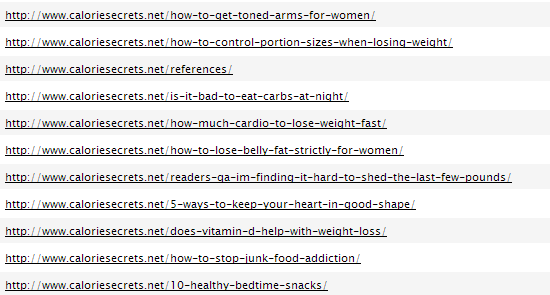
HTML sitemap (for users)
The user must provide site map links to all (pages of your site). It can also group articles written by you, date, category etc. Its purpose is to help the user find information on your site easier and faster. User site map - it looks like this:
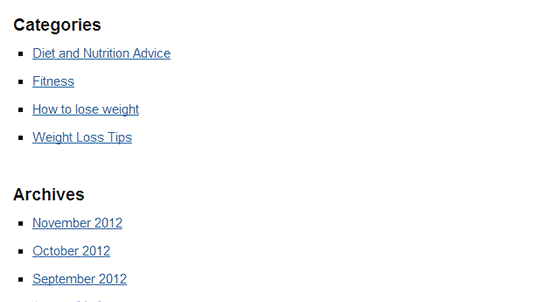
12. Content remains king
Before you do what you read above, you need, first and foremost, that the content be good. Content is still king, original, quality content can do better in the long run (with or without SEO).
What is good content?
When people search on Google, Yahoo or Bing they are essentially looking for the answer to a question. Good content is a post or page that answers that question.
How do I know if my content is good or not?
There is a simple way to understand whether your content is useful or not. You can check your analytics, page shares on social media and visitor stay time.
How to write good content ?
There is no simple answer to this question, but the following guidelines I have developed for you can point you in the right direction :
- Make sure your content delivers what is promised in the title. For example, if your title is “How to lose 15 kilos of fat in two days,” make sure that your message provides an accurate and clear description.
- Make sure the text is free of spelling and grammatical errors.
- Text formatting (as explained in point 8)
- Add links within your content (when necessary and not random) to other pages on your site (or external sites) to benefit the visitor by obtaining more information.
- Use reliable research or articles (if necessary) to prove that what you say or suggest is correct and applicable.
Does Google care about good content?
After launching Penguin, Google published a set of criteria to reach the first results. If it did not care about quality before anything else, it would not have released updates like Penguin.
13. Renewed content
The presence of new content is an incentive for visitors to come back again and is a good factor for the search engine to visit and crawl your site permanently.
This is true, it will be good when you really have something new to say about your specialized field or niche. Avoid publishing a small article or copying part of a second article to complete your article.
14. Check outgoing links
External links (the sites that you refer to from your site) are important in SEO . In general, I guarantee the following:
- You do not link your site to unwanted sites or sites with inappropriate content
- You have no broken links, any links to sites or pages that no longer exist (you can use xenu – a free tool to analyze external links for your site).
- Do not sell links to other sites within your site, and do not exchange links between yourself and another site
- Make any links in the comments section nofollow
15. Webmaster tools and Google statistics
Google and Bing have something called Webmaster Tools. This is the right place to register, submit your site to it, and follow statistics. After submitting it, you can visit Webmaster Tools and get valuable information about your website.
Confirm ownership of your site in Webmaster Tools
When you submit your site to Google Webmaster Tools and Bing Webmaster Tools you get a number of benefits:
- It's a way to tell search engines about your site (by submitting your site).
- It is a way to know which pages have been archived and which have not
- It is a way to get alerts if any problems occur that stop the site or hinder the crawling and archiving process.
- You can know the number of backlinks pointing to your site.
Also, it is very important to use Google Analytics (or any website traffic analysis tool):
- Know how visitors reach your site (direct visits, searches, conversions etc.)
- How much time they spend on your pages (and each page individually)
- What are the keywords that brought you visits?
- How many pages does each visitor visit?
After you've done all this, what next?
Follow the SEO Stars website to learn more. I will present to you everything new, all my experiences and mistakes, how I dealt with them, the strategies that worked for me, and years of experience working in the field of SEO.



